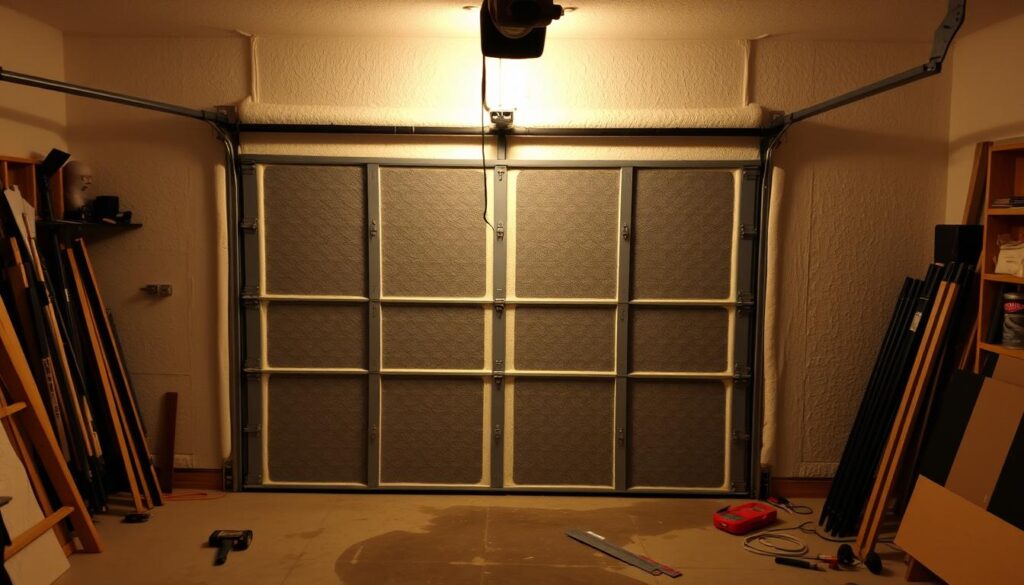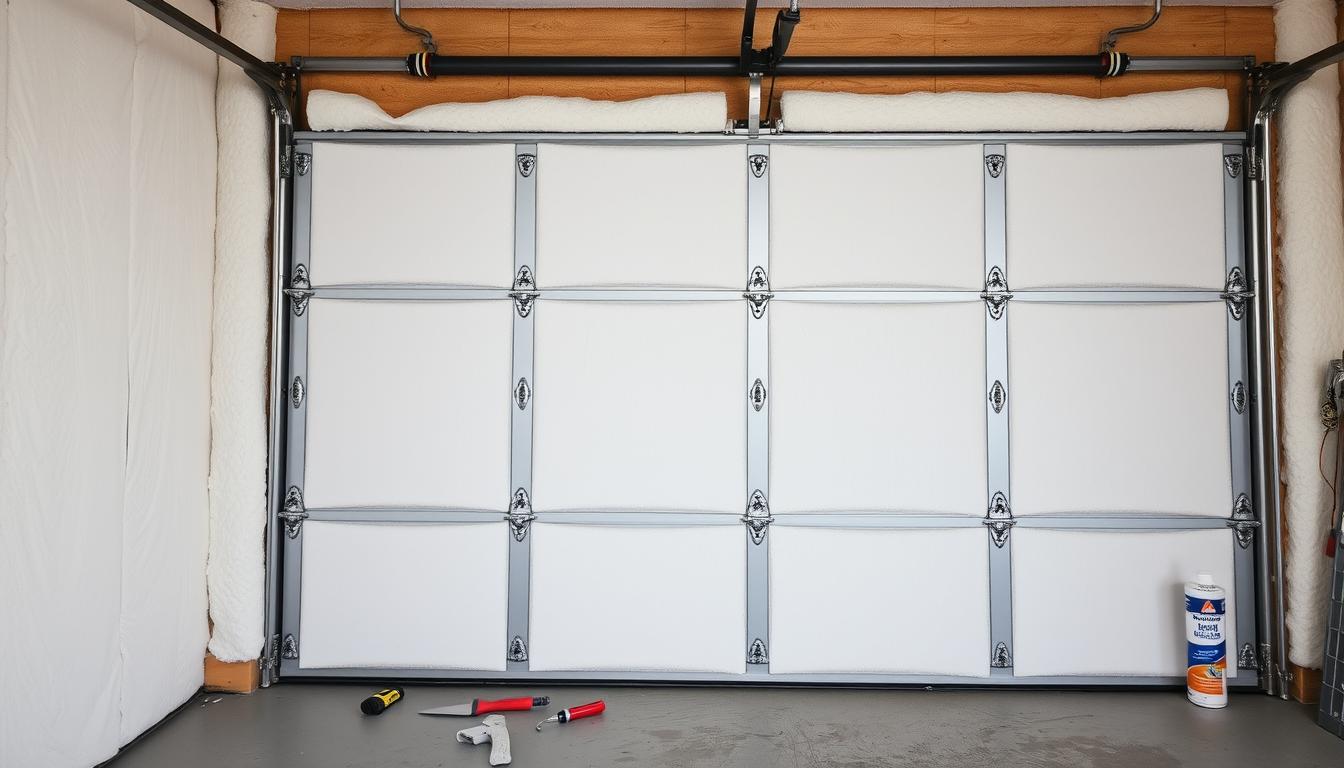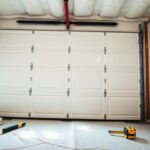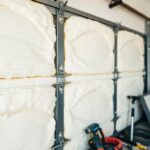Insulating your garage door is a smart move. It can make your home more energy-efficient. Garage doors can lose a lot of energy, making insulation key to keep your home comfy and cut down on bills. This guide will cover why insulation matters, the types of materials you can use, and how to install and keep your garage door insulated.
Key Takeaways
- Garage door insulation can improve energy efficiency and reduce heating/cooling costs
- Different insulation materials, such as rigid foam boards and reflective kits, offer varying levels of thermal performance
- Proper preparation, including cleaning and inspecting the door, is crucial for effective insulation installation
- Weatherstripping and sealing around the door’s edges help maximize the benefits of insulation
- Ongoing maintenance, such as inspecting and replacing worn weatherstripping, is important for maintaining insulation effectiveness
Introduction to Garage Door Insulation
Insulating your garage door is a simple yet impactful way to improve your home’s energy efficiency. Garage doors can be a significant source of heat loss or gain. This affects the temperature and comfort of your living spaces. By properly insulating your garage door, you can optimize your home’s thermal performance and enjoy a range of benefits.
Why Insulating Your Garage Door Matters
Garage doors are often overlooked when it comes to home insulation, but they play a crucial role in your home’s overall energy efficiency. Uninsulated garage doors can allow hot or cold air to pass through. This leads to higher energy costs and decreased comfort. Insulating your garage door helps to create a barrier that keeps the outdoor climate from affecting the temperature inside your home.
Benefits of Insulating a Garage Door
- Improved energy efficiency: Insulated garage doors help to retain heated or cooled air. This reduces the strain on your HVAC system and lowers your energy bills.
- Enhanced comfort: By maintaining a more stable temperature in your garage and adjacent living spaces, insulated garage doors can improve overall home comfort.
- Noise reduction: Insulated garage doors can help to muffle outdoor noises. This creates a quieter and more peaceful environment.
- Garage door insulation for cold weather: Properly insulating your garage door is especially important in cold climates. It helps to prevent heat loss and keep your garage and home warmer.
“Insulating your garage door is one of the most cost-effective ways to improve your home’s energy efficiency and comfort.”
By understanding the importance of garage door insulation and its associated benefits, you can take the first step towards creating a more energy-efficient and comfortable living space.
Types of Garage Door Insulation Materials
Insulating your garage door boosts energy efficiency and keeps your garage comfy. Homeowners have many insulation materials to choose from. Let’s look at the most common ones and what makes them special.
Rigid foam boards are a top pick. They’re made from materials like EPS or XPS, offering great heat resistance. These panels are easy to cut and fit, perfect for DIY projects.
Reflective insulation kits are another choice. They usually have a radiant barrier, like aluminum foil, attached to a strong backing. This type of insulation reflects heat away, improving thermal performance.
- Garage door insulation foam is simple and versatile.
- Insulation batts or blankets, from fiberglass or mineral wool, fit well and insulate effectively.
- Garage door insulation kits combine these materials for easier installation.
Choosing the right insulation depends on your garage door’s size, construction, and climate. Selecting the best insulation boosts your garage’s energy efficiency and comfort.
| Insulation Material | R-Value | Ease of Installation | Cost Considerations |
|---|---|---|---|
| Rigid Foam Board | 5-7 per inch | Moderate | Moderate to High |
| Reflective Insulation | 3-6 per inch | Easy | Moderate |
| Insulation Batts/Blankets | 3.7-4.3 per inch | Moderate | Low to Moderate |
“Insulating your garage door is a simple and cost-effective way to improve the energy efficiency of your home.”
Homeowners have many insulation materials to choose from. Knowing each option’s properties and installation needs helps pick the best one. This choice enhances your garage’s comfort and efficiency.
Preparing Your Garage Door for Insulation
Before you start insulating your garage door, you need to prepare the surface. This means getting the right garage door insulation supplies and cleaning the door. Proper preparation makes the garage door insulation installation easier and more successful.
Tools and Supplies Needed
To start, you’ll need some key garage door insulation supplies. These include:
- Measuring tape
- Utility knife or scissors
- Adhesive or spray foam
- Protective gloves and eyewear
- Clean rags or microfiber cloths
Cleaning and Inspecting the Garage Door
With your garage door insulation supplies ready, clean and inspect the door. Begin by wiping it down with a clean cloth to remove dirt and dust. Then, check for any cracks or gaps that need fixing before you start the garage door insulation preparation.
“Proper preparation is the key to a successful garage door insulation project. Take the time to ensure your door is clean and in good condition before you start.”
Preparing your garage door well sets you up for a smooth insulation installation. With the right garage door insulation supplies and some effort, you’ll soon enjoy a well-insulated garage door.
Installing Rigid Foam Board Insulation
Using rigid foam boards is a top choice for insulating your garage door. These panels boost the garage door insulation R-value, offering great thermal protection and energy savings. We’ll show you how to measure, cut, and install these garage door rigid foam insulation boards.
Measuring and Cutting the Insulation Boards
Start by measuring your garage door’s dimensions. Get the width and height of each panel for accurate measurements. This will help you figure out the right size of garage door insulation boards to buy.
When cutting the foam boards, use a sharp knife or panel saw for clean edges. Make sure each board fits well in the door’s frame, avoiding gaps.
Applying Adhesive and Securing the Boards
With the right-sized garage door rigid foam insulation boards, apply adhesive or caulk to the back. Spread it evenly for a strong bond. Place the boards on the garage door, pressing hard to secure them.
For extra stability, use screws or fasteners to attach the boards to the door.

By following these steps, you can install garage door insulation with rigid foam boards. This will make your garage door more energy-efficient and improve your home’s overall energy use.
Applying Reflective Insulation Kits
Reflective insulation kits make insulating your garage door easy and convenient. They usually have reflective foil or film that sticks to your door. This helps block heat transfer effectively.
DIY fans can easily apply these kits. Here’s a simple guide to start:
- Measure your garage door: Before buying, measure your door’s size to pick the right kit.
- Clean the door surface: Clean the door well to remove dirt and grease. This helps the insulation stick better.
- Cut the insulation to fit: Measure and cut the insulation to match your door panels.
- Apply the adhesive: Use the adhesive from the kit to stick the insulation to the door.
- Secure the insulation: Press the insulation firmly onto the door. Make sure it’s smooth and tight.
By following these steps, you can install garage door reflective insulation. This will make your garage more energy-efficient and comfortable.
“Reflective insulation kits are a game-changer for homeowners looking to enhance their garage’s comfort and energy performance.”
Reflective insulation kits are great for DIY projects or quick fixes. They’re a reliable and affordable way to insulate your garage door and boost its efficiency.
Using Insulation Batts or Blankets
Garage door insulation batts and garage door insulation blankets are great for insulating your garage door. They are flexible and can be cut to fit perfectly between the door’s panels or frame. This makes them a comprehensive insulation solution.
Cutting and Fitting the Insulation Batts
To install garage door insulation batts, just follow these steps:
- Measure your garage door’s panels or frame to find out how big the insulation batts need to be.
- Use a utility knife or scissors to cut the insulation batts to the right size. Make sure they fit snugly.
- Put the insulation batts into the spaces between the door panels or frame. Make sure they fit well.
- For extra stability, use construction adhesive or tape to keep the insulation batts in place.
By following these steps, you can install garage door insulation batts effectively. This will improve your garage’s thermal efficiency and save energy.

“Proper insulation can significantly reduce energy costs and improve the overall comfort of your garage space.”
Garage Door Insulation
Insulating your garage door is key to making your home more energy-efficient. It helps control the temperature, cuts down on energy costs, and boosts comfort all year round.
There are many insulation materials for garage doors, each with its own insulation values and perks. You can pick from rigid foam boards to reflective insulation kits. The best one for you depends on your garage door, the weather, and your preferences.
| Insulation Type | R-Value Range | Key Features |
|---|---|---|
| Rigid Foam Board | R-3 to R-12 | Blocks heat well, easy to put in |
| Reflective Insulation | R-3 to R-6 | Reflects heat, light and easy to use |
| Fiberglass Batts | R-8 to R-16 | Keeps heat in, can be trimmed |
Getting your garage door insulation installed right is important. Whether you do it yourself or get a pro, make sure to measure, cut, and secure it well. This will save you money and keep you cozy.
But remember, the garage door insulation value isn’t everything. Choose an insulation that fits your garage door and local weather.
“Insulating your garage door is one of the most cost-effective ways to improve the energy efficiency of your home.”
Sealing and Weatherstripping
Sealing and weatherstripping are key to a well-insulated garage door. They stop drafts, cut down on energy loss, and keep the garage at the right temperature. The right weatherstripping makes your garage more energy-efficient and comfortable.
Types of Weatherstripping for Garage Doors
There are many weatherstripping options for garage doors. Here are a few:
- Garage door jamb seals: These seals fit along the garage door frame’s sides. They block air leaks.
- Garage door bottom seals: Also called garage door dust seals, these are at the door’s bottom. They keep dust, debris, and drafts out.
- Garage door top seals: These seals are at the door’s top. They seal the gap between the door and frame, stopping air from getting in.
Choosing the right weatherstripping is important. Look for materials that are tough, weather-resistant, and fit your door. This ensures a good seal that boosts your garage’s insulation and energy efficiency.
| Weatherstripping Type | Key Benefits | Ideal Application |
|---|---|---|
| Garage Door Jamb Seal | Blocks air leaks, reduces drafts | Along the sides of the garage door frame |
| Garage Door Bottom Seal | Prevents dust, debris, and drafts from entering | Bottom edge of the garage door |
| Garage Door Top Seal | Seals the gap between the door and frame, blocks air infiltration | Top of the garage door |
Using the right weatherstripping for your garage door improves insulation and energy efficiency. It also makes your garage more comfortable and dust-free.
Maintaining and Caring for Insulated Garage Doors
Keeping your garage door insulation in good shape is key to its long life and your home’s energy use. Regular care and attention can prevent problems and keep your insulated garage door working well. Here are the important steps to maintain and care for your garage door insulation.
Cleaning and Inspecting the Insulation
Begin by cleaning your garage door insulation regularly. Use a soft-bristled brush or a vacuum attachment to remove dust, debris, or cobwebs. This keeps the insulation working well and avoids problems.
Look for any damage like cracks, tears, or loose spots. Fix any issues quickly to keep the insulation strong and prevent more damage.
Making Repairs and Replacements
If you find damaged areas, you can fix them with adhesive or sealant. But for big damage, you might need to replace the insulation. A pro can help with the garage door insulation maintenance and replacement.
Weatherstripping Maintenance
Check the weatherstripping around your garage door often. Look for cracks, gaps, or wear and replace it when needed. This keeps a tight seal and stops air leaks.
By doing these simple garage door insulation care steps, you can make your insulated garage door last longer. You’ll also keep enjoying better energy efficiency and temperature control in your home.
“Proper maintenance of your garage door insulation is essential for its long-term performance and your home’s energy efficiency.”
Cost Considerations and Savings
Insulating your garage door is a big step, but it’s worth it for the long-term savings and comfort. We’ll look at the costs and how they compare to the savings on energy bills and home value.
The garage door insulation cost depends on your garage door size, insulation type, and installation complexity. Garage door insulation kits cost between $50 and $300. Professional installation adds $200 to $500 or more. But, the savings on energy bills can make up for these costs over time.
Insulating your garage door lowers your energy bills by keeping the garage temperature steady. It also stops warm or cool air from escaping. Plus, an insulated garage door increases your home’s value, making it more attractive to buyers.
When thinking about insulating your garage door, consider the upfront cost against the long-term savings and benefits. The right insulation and installation make your garage more comfortable, lower your energy bills, and boost your home’s value.
“Insulating your garage door is one of the most cost-effective ways to improve the energy efficiency of your home. The savings you’ll see on your utility bills can make the investment well worth it.”
Conclusion
In summary, insulating your garage door boosts your home’s energy efficiency and comfort. By following the garage door insulation guide, you can learn how to insulate a garage door properly. This leads to lower energy costs, better temperature control, and more comfort at home.
This guide has covered different insulation materials and how to install them. We also talked about the need for regular maintenance and weatherstripping. Now, you’re ready to start your garage door insulation project and enjoy the benefits.
Choosing to insulate your garage door is a wise move. It improves your home’s energy use and livability. We hope this guide has given you the info you need to make a smart choice. Start your journey to a more comfortable, energy-saving home today.





